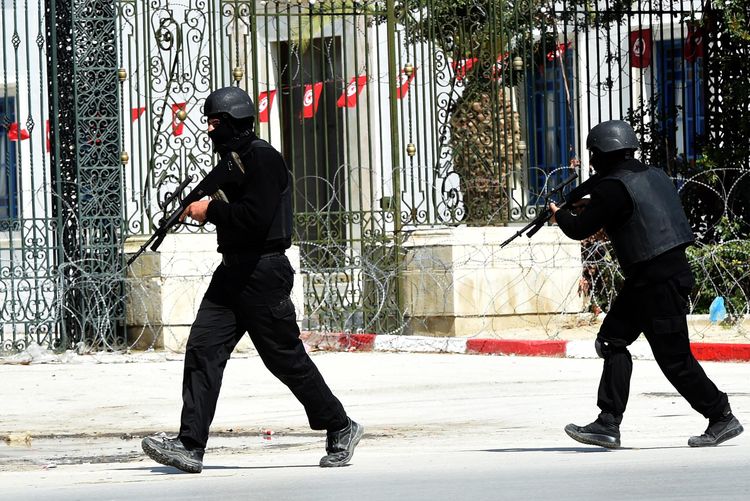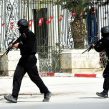
Fighting Terror in Tunisia: Domestic and Foreign Response to Bardo
Publication: Terrorism Monitor Volume: 13 Issue: 9
By:

Around midday on March 18, in Tunis, gunmen burst into the grounds of the Bardo Museum as tourists were alighting from buses and opened fire. The tourists fled into the museum and the gunmen followed, taking some of them hostage as security forces converged on the scene. The resulting standoff ended when security forces entered the museum and killed the gunmen (Webdo [Tunis], March 26; al-Jazeera, March 19). The attackers killed 22 people, wounded dozens more and left Tunisians reeling from the worst terrorist violence in over a decade. Tunisian leaders from across the political spectrum condemned the attack and vowed national solidarity, and thousands of Tunisians turned out for a march against terrorism in Tunis (Webdo [Tunis], March 30).
The attack also marked a sharp escalation of the terrorism that has gradually escalated since the revolution in 2011 toppled former president Zine El Abidine Ben Ali and laid the foundations of the country’s emerging democracy. Most attacks since the revolution have targeted security forces in the country’s hinterland, although some also targeted liberal and secular public figures (Terrorism Monitor, January 23). The Bardo attack, by contrast, struck at mainly foreign civilians in the capital. In response, the security forces quickly hunted down and killed its alleged organizer, Lokman Abu Sakhr (a.k.a. Khaled Chaïeb) (Webdo [Tunis], March 29). Since the attack, Tunisia’s allies have offered greater support that could give Tunisia an edge in the fight against terrorism. In the longer term, however, Tunisia’s security will also depend on resolving conflict in neighboring Libya that is making that country a regional terrorist hub.
Evolving Threat
Terrorism in Tunisia appears rooted in the country’s deeply conservative Salafist trend, whose religious views appear to provide some of the ideological underpinnings for violent jihad. While most Salafists reject violence, some embrace it as a means to realize their interpretation of a strictly Islamic society and state. The fall of Ben Ali’s secularist dictatorship opened space for renewed Salafist activism, which his regime had brutally suppressed. Salafist activists initially made religious demands such as the application of Shari’a and women’s right to wear the face-concealing niqab. However, some activists also rioted and vandalized over artwork they deemed blasphemous (al-Arabiya, June 12, 2014). Violence accelerated in 2012 when a Salafist-led mob ransacked and burned the U.S. Embassy in Tunisia and the nearby American Cooperative School (Tunisia-live.net, September 17, 2012). The following year, in August 2013, the authorities designated Tunisia’s leading Salafist group, Ansar al-Shari’a, which is blamed for the U.S. embassy attack, as a terrorist organization, having prohibited its activities since May (Tunisia-live.net, August 23, 2013; Tunisia-live.net, May 21, 2013).
Since then, militants often described by authorities and media as violent extremists have clashed increasingly with Tunisian security forces. Many incidents take place near the Algerian border, where militants are believed to be tax smugglers to fund their operations. Meanwhile, militants in Libya have sent Tunisian would-be jihadists to battlefields in the Middle East, such as Syria and Iraq, and have provided them with weapons and training. While the exact nature and strength of such alliances are hard to gauge, and may shift, a pattern of cooperation among militants across national borders seems to be emerging.
One striking example of such cooperation was a 2013 attack on the In Amenas gas facility in eastern Algeria, carried out by an Algerian-led splinter group from al-Qaeda’s North African franchise, al-Qaeda in the Islamic Maghreb, and reportedly involving a mix of fighters that included Tunisians and Egyptians. [1] Similarly, the alleged organizer of the Bardo attack, Sakhr, was reportedly an Algerian who, Tunisian authorities say, led Tunisia’s militant Katiba d’Okba Ibn Nafaa Brigade, based near the Algerian border (Webdo [Tunis] March 29). Sakhr’s career highlights how militant affiliations seem to cut across national boundaries.
In addition, there are indications that the Islamic State group, based in Iraq and Syria, and militants aligned with it, are trying to extend their reach into Tunisia. For instance, the Islamic State swiftly claimed credit for the Bardo attack in statements posted online and via its magazine, Dabiq (Webdo [Tunis], March 19). [2] The same issue of Dabiq also featured an interview with a prominent Tunisian Islamic State fighter who threatened Tunisian leaders and called for more Bardo-style attacks. A separate video posted online in April purported to show a Tunisian fighter with an Islamic State-aligned group in Libya threatening Tunisia’s government and inviting Tunisians to join him. [3] Such appeals raise fears that the Islamic State considers Tunisia a viable target for sustained violence.
Greater Foreign Support in the Works?
During the last year, Tunisian security forces have increased their counter-terrorism operations, notably around elections last fall. In December, the government also created a new body to analyze intelligence on terrorism from a range of state institutions (La Presse [Tunis], December 17, 2014). In March, the government submitted a new draft anti-terrorism law to parliament. (La Presse [Tunis], March 27). Meanwhile, key foreign allies, and particularly France, the United States and the UK, seem increasingly keen to support the country against terrorism.
After the Bardo attack, French Interior Minister Bernard Cazeneuve announced his country’s desire to ramp up security assistance. [4] French proposals include training assault teams, criminal analysts and border security personnel as well as helping build a database for biometric ID cards and passports and training police in crowd control according to international standards to help build trust with citizens, a French diplomat in the country told Jamestown. [5] France’s overall aim, said the diplomat, is to transform France’s periodic counter-terrorism support into an ongoing structural cooperation.
In April, U.S. Deputy Secretary of State Antony Blinken said the United States wanted to boost security assistance to Tunisia. [6] In February, the State Department requested $62.5 million in military financing for Tunisia in fiscal year 2016, more than double the 2015 request. [7] In January, Tunisia also received the second of two C-130J transport aircraft that it had bought from Lockheed Martin, and said it planned to buy eight UH-60M Blackhawk helicopters from Sikorsky, another U.S. firm (Embassy of the United States Tunisia, January 8).
The State Department also wants $12 million in fiscal year 2016—up from $7 million the previous year—for the Bureau of International Narcotics and Law Enforcement Affairs (INL), which offers counter-terrorism training, to spend on Tunisia. [8] So far, the INL has trained Tunisian security forces in crowd control and hostage-rescue, and it wants to train them in investigation techniques. [9] A U.S. diplomat in Tunisia told Jamestown that the INL’s decision to expand its assistance predates the Bardo attack, and is based on Tunisia’s holding of elections and what the United States considers Tunisia’s commitment to democratic security sector reform. More broadly, the U.S. diplomat said, the United States is eager to see Tunisia move forward on reforms “entailed in its democratic consolidation.” These include economic reforms as well as reforms to security services and the judiciary, the diplomat said. [10]
The UK has also provided counter-terrorism training and equipment, including bomb detection gear, to Tunisia since 2011. Britain may boost this support, a British diplomat in Tunisia told Jamestown. [11] According to a statement after the Bardo attack by UK Foreign Minister Philip Hammond, London’s Metropolitan Police Counter Terrorism Command, as well as military counter-terrorism experts, will offer long-term capacity building to the country. [12]
Libyan Dimension
Since the 2011 civil conflict that toppled Mu’ammar Gaddafi, Libyan authorities have struggled to control the country. As a result, Libya is awash with weapons and with armed groups ranging from local militias to international jihadists. In addition, Libyan politics is today polarized between Islamists and non-Islamists, and rival governments sit in Tripoli and in the eastern city of Tobruk. The crisis has dramatically empowered Islamist militants, including groups in Tripoli, Sirte and Derna that have aligned with the Islamic State. This instability also threatens neighboring countries, including Tunisia, as militants exploit the chaos there to expand their operations abroad. The Islamic State itself has encouraging would-be jihadists to relocate to Libya as an alternative to elsewhere in the Middle East. [13]
Outlook
Tunisia is widely acknowledged as the best hope for peace and democracy to have emerged from the 2011 Arab Spring uprisings. However, the Bardo attack highlighted both the growing internal and external militant threat to the country. However, while Tunisia’s allies seem determined to strengthen their support and cooperation, money will be an important deciding factor, and it remains to be seen how much foreign governments are willing or able to contribute. The French diplomat told Jamestown that some assistance may be multi-lateral, and some funding may come from the United Nations or the European Union. [14] A further persistent challenge will remain Libya, where the lack of political stability makes effective counter-terrorism work almost impossible. The success of UN-led talks aimed at forming a Libyan national unity government is far from certain, while an international peacekeeping force is unpalatable to many Libyans and thus unlikely, a Western diplomat told Jamestown. [15] This underlines that Tunisia, despite its recent achievements, remains for now a fledgling democracy in a rough neighborhood.
John Thorne is a journalist based in Tunis. He has covered North Africa since 2006.
Notes
1. “The In Amenas Attack,” Statoil ASA, February 2013, p. 39.
2. “Interview with Abu Muqatil,” Dabiq, Issue 8 (April 2015), p. 62.
3. “Tunisian IS Fighter in Libya in Libya Calls Countrymen to Join Him in Video, Threatens Tunisian Government,” SITE Monitoring Group, April 8, 2015.
4. Interview with French diplomat charged with internal security affairs, Tunis, April 22, 2015.
5. Statement to media by Bernard Cazeneuve, French Embassy in Tunis, March 20, 2015.
6. Statement to media by Antony Blinken, U.S. Embassy in Tunis, April 10, 2015.
7. “Congressional Budget Justification, Fiscal Year 2016,” Department of State, Foreign Operations, and Related Programs, February 2, 2015, p. 181; “Congressional Budget Justification, Fiscal Year 2015,” Department of State, Foreign Operations, and Related Programs, March 4, 2014, p. 175
8. “Congressional Budget Justification, Fiscal Year 2016,” Department of State, Foreign Operations, and Related Programs, February 2, 2015, p. 172; “Congressional Budget Justification, Fiscal Year 2015,” Department of State, Foreign Operations, and Related Programs, March 4, 2014, p. 107.
9. “Factsheet on Bureau of International Narcotics and Law Enforcement Affairs programs for Tunisia,” U.S. State Department.
10. Interview with U.S. diplomat, Tunis, April 23, 2015; Email from U.S. diplomat in Tunis, April 27, 2015.
11. Interview with British diplomat, Tunis (by telephone), April 21, 2015.
12. Statement by Philip Hammond to the House of Commons, March 20, 2015.
13. “The Libyan Arena,” Dabiq, Issue 8 (April 2015), p. 26.
14. Interview with French diplomat charged with internal security affairs, Tunis, April 22, 2015.
15. Interview with Western diplomat, Tunis, April 23, 2015.





